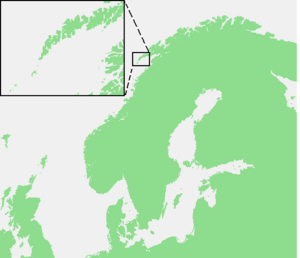Operation Anklet facts for kids
Quick facts for kids Operation Anklet |
|||||||
|---|---|---|---|---|---|---|---|
| Part of the North West Europe Campaign | |||||||
 Lofoten Islands |
|||||||
|
|||||||
| Belligerents | |||||||
| Commanders and leaders | |||||||
Naval: Captain Hugh Dalrymple-Smith Land: Lieutenant Colonel S.S. Harrison |
|||||||
| Strength | |||||||
|
Naval: No. 12 Commando 223 men Norwegian Company 77 men |
Eight divisions in Norway three coastal defence four infantry one Luftwaffe Field Division Unknown number of aircraft and naval forces |
||||||
| Casualties and losses | |||||||
| 1 light cruiser heavily damaged | 1 patrol ship sunk 2 wireless stations destroyed |
||||||
Operation Anklet was a secret mission during World War II. It was a raid by British Commando soldiers on the Lofoten Islands in Norway. This happened in December 1941. About 300 soldiers from No. 12 Commando and the Norwegian Independent Company 1 took part. They were helped by 22 ships from three different navies.
At the same time, another bigger raid called Operation Archery was happening nearby. Operation Anklet was a "diversionary raid." This means it was meant to distract German forces. The goal was to pull German ships and planes away from the main attack.
Why the Raid Happened
After many British soldiers left Dunkirk in 1940, Britain's leader, Winston Churchill, wanted to fight back. He asked for a special force to attack the Germans. Churchill wanted "hunter class" troops to cause trouble along the enemy coast.
A military officer, Dudley Clarke, had already suggested this idea. The British Army's chief, John Dill, liked the plan. So, the Commandos were formed. These were special soldiers trained for quick, surprise attacks.
Volunteers from the British Army joined the Commandos. Some had even fought in Norway before. The Commandos were part of a group called Combined Operations Headquarters.
The Lofoten Islands are off the coast of Norway, inside the Arctic Circle. Operation Anklet was the second raid on these islands. The first was Operation Claymore in March 1941. A third raid, Operation Archery, happened at the same time as Anklet.
The Combined Operations Headquarters planned this raid. Only naval ships and land troops were used. The Royal Air Force (British air force) was not involved. This was the last raid without air support.
The Ships and Soldiers
A large group of 22 ships was gathered for Operation Anklet. They came from three navies. The Royal Navy (British navy) provided most of the ships. These included a light cruiser (a fast warship) called HMS Arethusa. There were also six destroyers, three minesweepers, and two Landing Ship Infantry (ships that carry soldiers). Two submarines and a survey ship also joined.
The Royal Fleet Auxiliary, which supports the navy, sent two tankers. They also sent a cargo ship and a tugboat.
The Royal Norwegian Navy (Norway's navy in exile) provided two corvettes (smaller warships). The Polish Navy (Poland's navy in exile) sent two destroyers.
The soldiers for the landing were 223 men from No. 12 Commando. They were joined by 77 men from the Norwegian Independent Company 1.
The Mission
The ships gathered at three places in Britain: Scapa Flow, Greenock, and Lerwick. This group of ships was called Force J. They left for the Lofoten Islands on December 22 and 23. One ship, the Prinses Josephine Charlotte, had engine trouble. It had to go back to port.
As the ships got close to the islands, a submarine, HMS Sealion, was already waiting. It acted like a guide for the attack. The raid was planned for December 26.
When Force J arrived, one ship, the Prins Albert, went to Moskenesøya island. It carried the Commandos. Other ships did different tasks around the islands. The destroyer HMS Bedouin destroyed a German radio station. The cruiser HMS Arethusa and other destroyers went into the Vestfjorden. There, they captured two Norwegian ships. One destroyer, HMS Ashanti, sank a German patrol boat.
The 300 soldiers landed at 6:00 AM on Boxing Day. This date was chosen because the British thought the German soldiers would be busy with Christmas celebrations. They hoped to catch them by surprise. The soldiers, wearing white camouflage, landed without any fighting. They quickly took over the villages of Reine and Moskenes. They captured the small German group and some Norwegians who supported the Germans at a radio station.
On December 27, a German seaplane attacked the cruiser HMS Arethusa. The ship was not directly hit, but it was damaged. It needed 14 weeks of repairs. Since the British had no air support, the raid's commander, Admiral Frederick Dalrymple-Hamilton, decided to leave. After two days, they headed back to Scapa, arriving on January 1, 1942.
What Happened Next
During Operation Anklet, two German radio stations were destroyed. Several small German boats were captured or sunk. A few German soldiers and their Norwegian helpers were taken as prisoners of war. The British navy also captured a secret Enigma machine from a sunk patrol ship. This machine was used by the Germans to send coded messages.
The raid also brought back over 200 Norwegians. These people volunteered to join the Free Norwegian Forces and fight against Germany. The raid was a success, and no Allied soldiers were lost.
One important lesson was learned: future raids needed air support. This was the last raid without it. During the war, there were 12 Commando raids on Norway. In response, Germany sent more and more soldiers to Norway. By 1944, there were 370,000 German soldiers stationed there.


